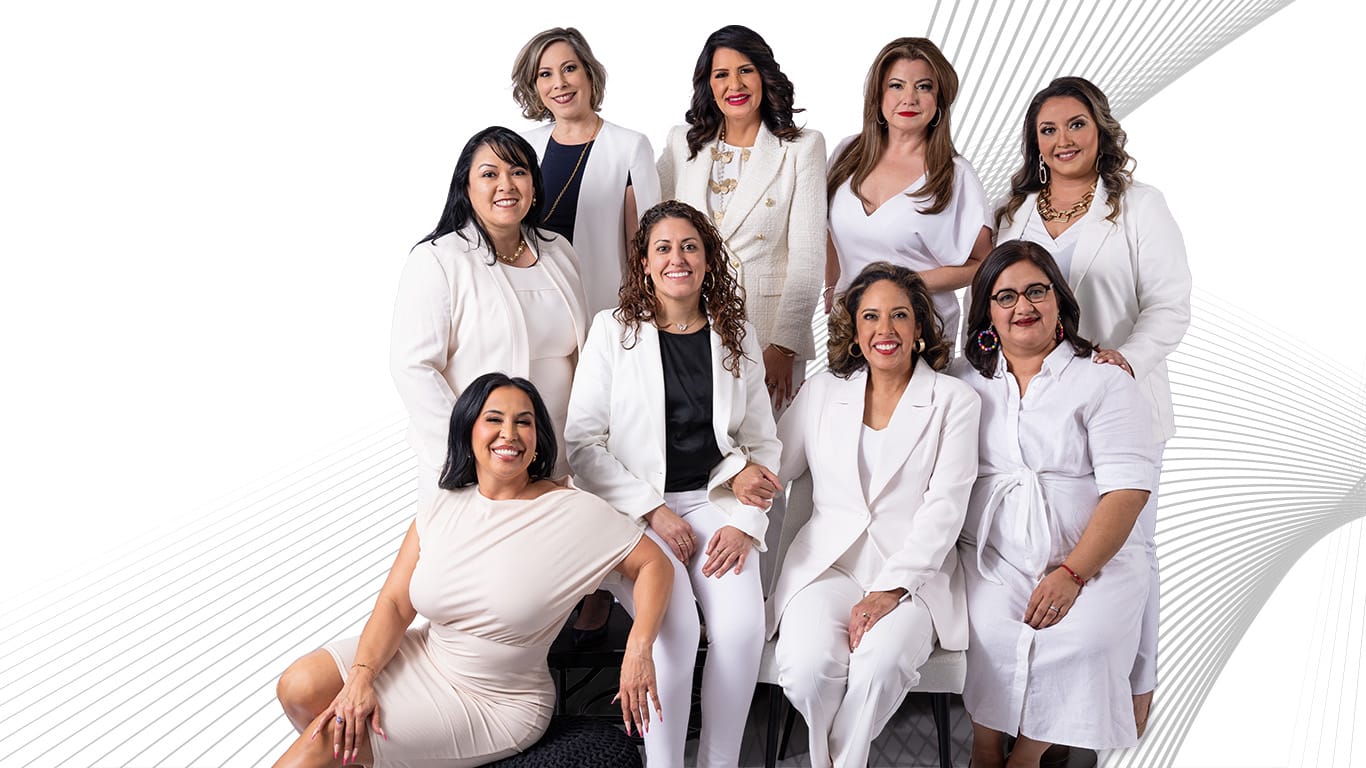It’s an unprecedented time for Latina leaders in Arizona. And, it’s a watershed moment in Az Business magazine history, to be able to showcase nine of the state’s most respected and admired Latina business leaders on the cover of the March issue. During our cover shoot, we had a rare opportunity to interview these women together, and in doing so, witnessed the connectedness and strength of Arizona’s Latina business community. These women are not only breaking the glass ceiling — but they’re also clearing the way for the next generations of Latinas and paying tribute to those who walked before them. Read more about their inspiring journeys and what comes next for Latina leaders in Arizona.
Why now?
Nationally, statistics of Latinas in leadership positions are dismal. According to a recent article, Latina women held 4.3% of leadership positions in 2021, compared with 32.6% held by white women. But with Arizona rising from the fifth to the fourth largest Hispanic population in the country, could the tide be turning? With more Latinas filling the C-suite and launching their own companies, it’s a step in the right direction — and right timing.
“I think it’s our time and we’re coming out of the shadows,” says Monica Villalobos, president and CEO of the Arizona Hispanic Chamber of Commerce. “And we know that in business, the fastest growing segment is Hispanic women.”
Adds Alicia Nuñez, interim president and CEO of Chicanos Por La Causa (CPLC), “The world is starting to wake up and see the unique value that Latinas bring. For so long, we have been ignored and many of us have internalized it ourselves. Today, Latinas are feeling empowered to not hold ourselves back and to start seeing ourselves as leaders.”
Anna María Chávez, CEO of Arizona Community Foundation, echoes the sentiments of Nunez, noting, “We’ve always been here. For many of us who are natives, this is where we were born and raised. And some of us, we went away for school, maybe got some career experience in other states, but we’ve been pulled back home to serve. And I think that’s why you’re seeing multigenerational Latinas get into leadership roles.”
In addition to owning their empowerment, Gaby Cardenas, founder and CEO of The Colibri Collective, points to another advantageous avenue for Latinas in which to embrace leadership.
“Just the economy alone — Hispanics in Arizona pack $57 billion in spending power — should not be ignored and we should own that power,” she says. “I think that in C-suite opportunities, sometimes they’re slim. But like I always say, ‘If we’re not invited to the table, we need to be a part of that table and we need to be mentors.’ If we’re not being mentors, we need to really uplift each other. It’s not easy to get in those spaces.”
For Latinas in business, representation is everything
Organizations like E.L.L.A (Empowering Latina Leaders in Arizona), the Arizona Hispanic Chamber of Commerce, Chicanos Por La Causa, the Arizona Hispanic Bar Association and similar entities are supporting the growth, advocacy and awareness of Latinas in business and leadership.
“We are a large Latino-led organization, that has been around in Arizona for 55 years, but we’ve expanded into five other states,” Nuñez says. “We believe and focus on communities that have been disadvantaged and forgotten, which a lot of Latinos were. We focus on providing access to capital for small businesses and access to education.”
According to Stephanie Vasquez, founder and CEO of E.L.L.A., her organization has worked with more than 500 local Latino businesses. “When we look at businesses and small businesses, Latinas are leading,” she says. “It’s important for organizations like ours to be there to help and support the little guys.”
Adriana Kong Romero, president of Bank of America Tucson, relays that it’s vital for businesses to reflect the demographics in which they operate. “Seeing a marriage between the communities that you live and work in is important. And when you look at business as well, you should ask ‘Do they know of the resources available to them, access to capital and even just having those cohorts that they can talk to and see themselves in that growth?’”
Adds Carla Vargas Jasa, president and CEO of Valley of the Sun United Way, “My executive leadership team is 75% Latina,” she says. “And that’s because they’re the most capable people for the roles and I could not be more proud to see that.”
Of the nine cover shoot participants, they all unanimously agreed that representation — either within Hispanic-focused organizations or outside of them — is one of the most powerful ways to continue the legacy of Latina leaders.
“When you’re out in Arizona, you see yourself and other people around you and you don’t feel like you’re the minority,” says Karla Moran, principal economic development analyst at SRP. “So when you see a CEO or another woman in a leadership position, you can aspire to be that yourself.”
“It’s all about allyship,” Chávez says. “This is my fifth time being a CEO. I can tell you that I’ve walked into positions where I’m either the first woman of color or person of color in these roles and because of that, I may not necessarily have the same network setup as others who’ve come before me.”
Next steps
Ensuring Latinas continue to fill leadership roles requires the continued support of organizations — in a myriad of ways.
“I think it has to come from the top business leaders,” Chávez says. “Corporations need to make sure they enforce it. Diversity and inclusion is key and making sure that we look at every type of individual race and background and being able to promote and foster that within their organization.”
Adds Vargas, “I’m really excited being a part of an organization like United Way. We’ve been able to develop a phenomenal new program to bridge the generational wealth gap for young Black and Latina women through pathways of economic opportunity. [This includes] getting mentors to provide internships and externship shadowing so that they can pay it forward.”
Alongside formal and informal mentorship and DEI initiatives, the Latina powerhouses on the cover of Az Business also reiterated the importance of Latinas simply “going for it” — applying for leadership positions no matter what.
“We need to lean in and go for jobs that we aspire to, even if we don’t check every box,” says Erika Castro, supplier diversity program manager at SRP. “Men go for jobs when they meet 60% of requirements, while females feel they need to meet 100%. This means they are applying for 20% less jobs than men.”
Castro explains that enacting a posture of confidence is even more important as an example to the next generation of Latinas, especially given the fact that Arizona’s K-12 system is now a Hispanic majority.
So does Villalobos. “Fly that freak flag, right? Whenever that is, whatever that is. If it’s the big earrings, if it’s the lips — whatever that is. Don’t be afraid. I remember a young woman once asking me, ‘When do you stop being afraid?’ And I said, ‘You never do, but you learn to channel that.’”
Adds Romero in closing, “Challenge yourself, but then also embrace your uniqueness. Everyone is special in their own way and it’s you that can harness that superpower.”




